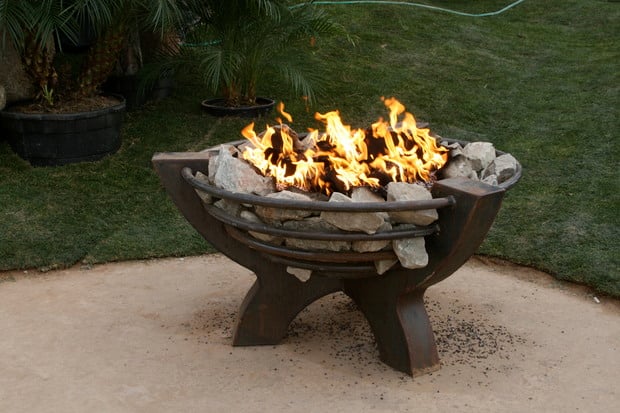
Homeowners are increasingly adding fire pits to their outdoor spaces. Fire pits are popular as they can be used year round, in hot and cold weather, as a gathering space. If you are considering adding a fire pit to your backyard, there are several things that need to be considered including location, budget, fuel type, and most importantly, safety.
Where to Place Your Fire Pit
Before deciding where to place your fire pit, you will need to determine whether you will be installing a permanent fire pit, or purchasing a portable fire pit. There are many options for both portable and permanent fire pits when it comes to design and price. Once you have determined whether you will have a permanent or portable fire pit, you will need to decide where the best placement is. Determining placement is especially important for permanent fire pits as they may require remodeling or renovation work prior to installation.
When deciding where to place your fire pit, the most important thing to consider is safety. Fire pits should be placed at a minimum of ten feet away from your house and also neighbors yards. In addition to placing the fire pit a safe distance away from your home, it should also be in a place where there are no overhanging branches, fences or other structures that could easily catch fire. It is important to check the requirements within your city or town as codes and laws regarding the use of fire pits can differ. Some communities do not allow open fires so check with officials prior to making any plans to install a fire pit.
In addition to determining a location for your fire pit, you will need to figure out the best surface for it. Safe fire pit surfaces include brick, stone, gravel, concrete, or some type of fire resistant composite material. Fire pits should never be placed on wood decks as this is a serious fire hazard. Generally, fire pits are constructed on a gravel or stone base.
How much is a load of gravel? Most homeowners spend between $4 – $6 per bag, or more for colorful stones.
Type of Fuel
Generally, gas and wood, are the most common types of fuel for outdoor fire pits. Those looking for a true experience often prefer burning real wood however that requires close supervision to keep the flames going, in addition to a sufficient supply of firewood. Besides real wood, the other fuel option for fire pits is gas. The use of gas or propane means that the fire will start instantly, but you don’t get the traditional smoke and crackling noises of a wood fire. There are some fire pits that can be purchased that allow for switching between wood and gas. Gas and propane should only be used in devices that are built for them. Flammable fluids such as gas or lighter fluid should never be used to light wood fires.
Fire Pit Safety Tips
Fire pits can be great for gathering friends and family however the use of a fire pit requires serious attention to safety. Prior to using your fire pit, you should check with your insurance company as disclosure of your fire pit may be a requirement of your policy. Before lighting the fire, check the direction of the wind. You should also avoid wearing loose fitting clothing around the fire in addition to flammable clothing such as nylon, that could easily catch fire. Soft woods such as cedar and pine, have a tendency to throw sparks, and pop, so avoiding these woods can cut down on the risk of injury and the spread of fire. It is also important to know how to properly extinguish your fire as well as how to safely dispose of ashes.
More About Fire Pit Safety
- Brush Up On Basic Fire Pit Safety
- How Far From a Tree is it Safe to Build a Fire Pit?
- Smokey Bear – Be Smart Outdoors to Prevent Wildfires
- Tips for Fire Safety in the Outdoors
- Outdoor Fire Safety Tips for Kids
- Outdoor Fire Pits and Fire Pit Safety
- Firefighters Share Fire Pit Safety Tips
- 5 Fire Pit Safety Tips From a Former Wildland Firefighter
- Summer Fire Pit Safety Tips
- Hot Safety Tips for Backyard Fire Pits
- Tips for Fire Pit Safety
- Fire Pit Safety Tips – Advice for a Safe Season
- Using Grills and Fire Pits Safely This Summer
- Playing With Fire: Tips for Fire Pit Safety
- Fire Pit Burning – Safety Tips
 Chimney Bombs
Chimney Bombs  Chimney Maintenance Keeps Your Family Safe
Chimney Maintenance Keeps Your Family Safe  How to Keep Smoke Out of Your Home
How to Keep Smoke Out of Your Home  11 Home Security and Safety Tips
11 Home Security and Safety Tips  Staying Safe During a Home Power Outage
Staying Safe During a Home Power Outage 

Great tips! I think it’s important when buying or using a fire pit to review the safety aspects. It’s all fun and games until someone gets hurt. Be proactive and avoid potentially harmful situations!